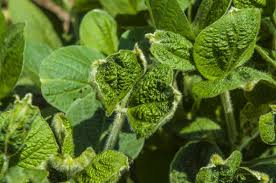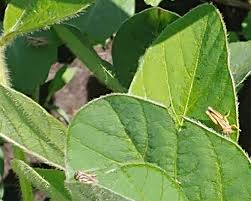Soybean leaves are an essential part of the soybean plant (Glycine max). They play a crucial role in the plant’s growth, photosynthesis, and overall health. Soybean leaves are typically compound leaves, meaning they consist of multiple leaflets attached to a central stem or petiole. Each leaflet is elongated and has a somewhat oval shape, with a pointed tip and a tapered base.
The leaves are arranged alternately along the stem, which means that each leaf emerges from a different point on the stem, creating a staggered pattern. The number of leaflets per leaf can vary, but it’s common to have three leaflets per leaf. This is referred to as a trifoliate leaf arrangement. However, some soybean varieties can have more leaflets per leaf.
The color of soybean leaves can vary based on factors such as plant health, age, and environmental conditions. Healthy leaves are typically green, but they can range from lighter to darker shades depending on the cultivar and growth stage. Like other plants, soybean leaves play a vital role in photosynthesis. They contain chloroplasts, which contain the pigment chlorophyll that captures light energy and converts it into chemical energy.
Soybean leaves also facilitate transpiration, which is the process of water loss from the plant through small openings called stomata on the leaf surface. This helps regulate the plant’s temperature and helps with nutrient transport.
Just like any other plant, soybean leaves are susceptible to various diseases and pests that can affect their health and function. Common diseases include soybean rust and various leaf spot diseases. Pests such as aphids, caterpillars, and mites can also damage soybean leaves.
Leaf Arrangement for Identification: The arrangement of soybean leaves along the stem and the number of leaflets per leaf can be used as a characteristic for identifying soybean plants and differentiating them from other plants.
The Economic Importance and Uses of Soybean Leaves

Soybean leaves, while often overshadowed by the economic importance of soybean seeds, have various uses and economic significance.
Here are some of the key economic uses and benefits of soybean leaves:
1. Livestock Feed: Soybean leaves can be used as a nutritious fodder for livestock, especially for ruminants like cattle, sheep, and goats. They are rich in protein, fiber, vitamins, and minerals, making them a valuable dietary supplement for animals. Incorporating soybean leaves into animal feed can improve the overall nutritional content and quality of the feed, leading to better animal health and growth.
2. Green Manure: Soybean leaves can be used as a green manure crop. When grown and then plowed into the soil, they enrich the soil with organic matter, nitrogen, and other nutrients, thereby enhancing soil fertility and structure. This practice is particularly beneficial for sustainable and organic farming systems, as it reduces the need for synthetic fertilizers and promotes healthy soil ecosystems.
3. Medicinal Uses: Soybean leaves have been traditionally used in some cultures for their potential medicinal properties. They are believed to possess antioxidants, anti-inflammatory compounds, and other bioactive substances that could have health benefits. However, scientific research in this area is ongoing, and more evidence is needed to confirm their specific medicinal applications.
4. Mulch and Biomass: Soybean leaves can be used as mulch or ground cover in agricultural fields and gardens. They help retain soil moisture, suppress weed growth, and improve overall soil health. Additionally, soybean leaves can be utilized as a source of biomass for bioenergy production, such as in the generation of biogas or as feedstock for biofuel production.
5. Food for Human Consumption: While less common, in some cultures, young soybean leaves are used as a vegetable in traditional dishes. They can be consumed as a salad green or cooked as a nutritious side dish. However, this usage is not as widespread as the consumption of soybean seeds.
6. Research and Innovation: Soybean leaves also have a role in research and innovation. Scientists study their genetic makeup and biochemical composition to develop improved soybean varieties with enhanced nutritional profiles, disease resistance, and other desirable traits. These advancements contribute to the improvement of soybean crops and their overall economic value.
7. Environmental Benefits: The cultivation of soybean plants, including leaves, can have positive environmental impacts. Soybean plants are known for their ability to fix atmospheric nitrogen into the soil through a symbiotic relationship with nitrogen-fixing bacteria. This reduces the need for synthetic nitrogen fertilizers, which can lead to reduced greenhouse gas emissions and less nitrogen runoff, thereby mitigating environmental pollution.
8. Crop Rotation and Pest Management: Soybean leaves are part of the soybean plant, which can be included in crop rotation strategies. Rotating soybeans with other crops helps break pest and disease cycles and can lead to healthier, more productive agricultural systems. Moreover, soybean leaves can contribute to integrated pest management by acting as a habitat for natural predators of pest insects, helping to reduce the need for chemical pesticides.
Read Also: Comprehensive Step by Step Guide on SoyaBean Farming
9. Byproduct Utilization: In soybean processing facilities, where soybeans are processed for their seeds, leaves can be considered a byproduct. These leaves can be utilized further to extract valuable components, such as antioxidants, pigments, or bioactive compounds, which have applications in the food, pharmaceutical, or cosmetic industries. By creating value-added products from soybean leaves, industries can generate additional revenue streams.
10. Education and Extension: Soybean leaves play a role in educational programs and extension services for farmers and agricultural professionals. Demonstrating the benefits of incorporating soybean leaves into livestock feed, as green manure, or for pest management can help disseminate sustainable and efficient agricultural practices, leading to better economic outcomes for farmers.
11. Cultural and Traditional Uses: In some cultures, soybean leaves may hold cultural or traditional significance beyond their economic uses. They might be used in rituals, ceremonies, or as symbols of agricultural practices and heritage. Preserving and celebrating these cultural connections can have intrinsic value and contribute to community identity.
12. Biodiversity and Ecosystem Services: The cultivation of soybean plants, including their leaves, can have positive effects on biodiversity and ecosystem services. Soybean fields can provide habitat and food sources for various wildlife species, contributing to local biodiversity. Additionally, the incorporation of soybean leaves into the soil can improve soil health, water retention, and overall ecosystem resilience.
The Products and By-products That Can Be Derived From Soybean Leaves

Soybean leaves, like many plant materials, contain a variety of compounds that can be extracted or processed to produce different products and by-products.
Here are some examples:
1. Soybean Leaf Extracts: Various compounds present in soybean leaves can be extracted using solvents like water, ethanol, or methanol. These extracts can contain phytochemicals such as flavonoids, phenolic compounds, and antioxidants, which have potential health benefits.
2. Herbal Supplements and Tea: Soybean leaf extracts can be used as ingredients in herbal supplements or teas due to their antioxidant and potential health-promoting properties. These products might be marketed as natural remedies for various ailments.
3. Natural Dyes: Some compounds in soybean leaves possess natural dyeing properties. These dyes can be extracted and used for coloring textiles, papers, or other materials in a sustainable and environmentally friendly manner.
4. Animal Feed: Soybean leaves can be used as a component of animal feed, especially for ruminants and livestock. They contain valuable nutrients like protein, fiber, vitamins, and minerals that contribute to the animals’ diet.
5. Fertilizer and Soil Amendment: Soybean leaves can be composted and turned into organic matter for enriching soil quality and fertility. They contribute organic carbon, nitrogen, and other nutrients when incorporated into compost or used as mulch.
6. Biogas Production: Soybean leaves can be used as a substrate for biogas production through anaerobic digestion. Microorganisms break down the organic matter in the leaves, producing methane-rich biogas that can be used for energy generation.
Read Also: Rice Spikelets: Economic Importance, Uses and By-Products
7. Pharmaceuticals: Some compounds found in soybean leaves may have potential pharmaceutical applications. Research is ongoing to explore their use in developing drugs for various medical conditions.
8. Cosmetics and Skincare Products: Extracts from soybean leaves can be used in cosmetic and skincare formulations due to their potential skin-soothing and antioxidant properties.
9. Flavoring Agents: Extracts from soybean leaves can be used to add unique flavors to foods and beverages, similar to how other botanical extracts are used in the culinary industry.
10. Bioactive Compounds: Soybean leaves contain bioactive compounds that may have anti-inflammatory, antimicrobial, or other health-related properties. These compounds can be isolated and studied for potential therapeutic applications.
11. Agricultural Pesticides: Some compounds in soybean leaves might have pesticidal properties. These can be developed into natural alternatives to synthetic pesticides for agricultural applications.
12. Art and Crafts: Dried soybean leaves can be used in arts and crafts projects, such as making decorative items, handmade paper, or pressed leaf art.
13. Educational and Research Purposes: Soybean leaves can be used in educational settings for botanical studies, plant identification, or experiments related to plant biology.
In conclusion, while soybean leaves might not be as well-known as soybean seeds, they offer a range of economic and ecological benefits across various sectors. From sustainable agriculture and livestock production to potential byproduct extraction and cultural significance, soybean leaves contribute to a holistic approach to agricultural and environmental management.
Read Also: Benefits of Automated Farming
